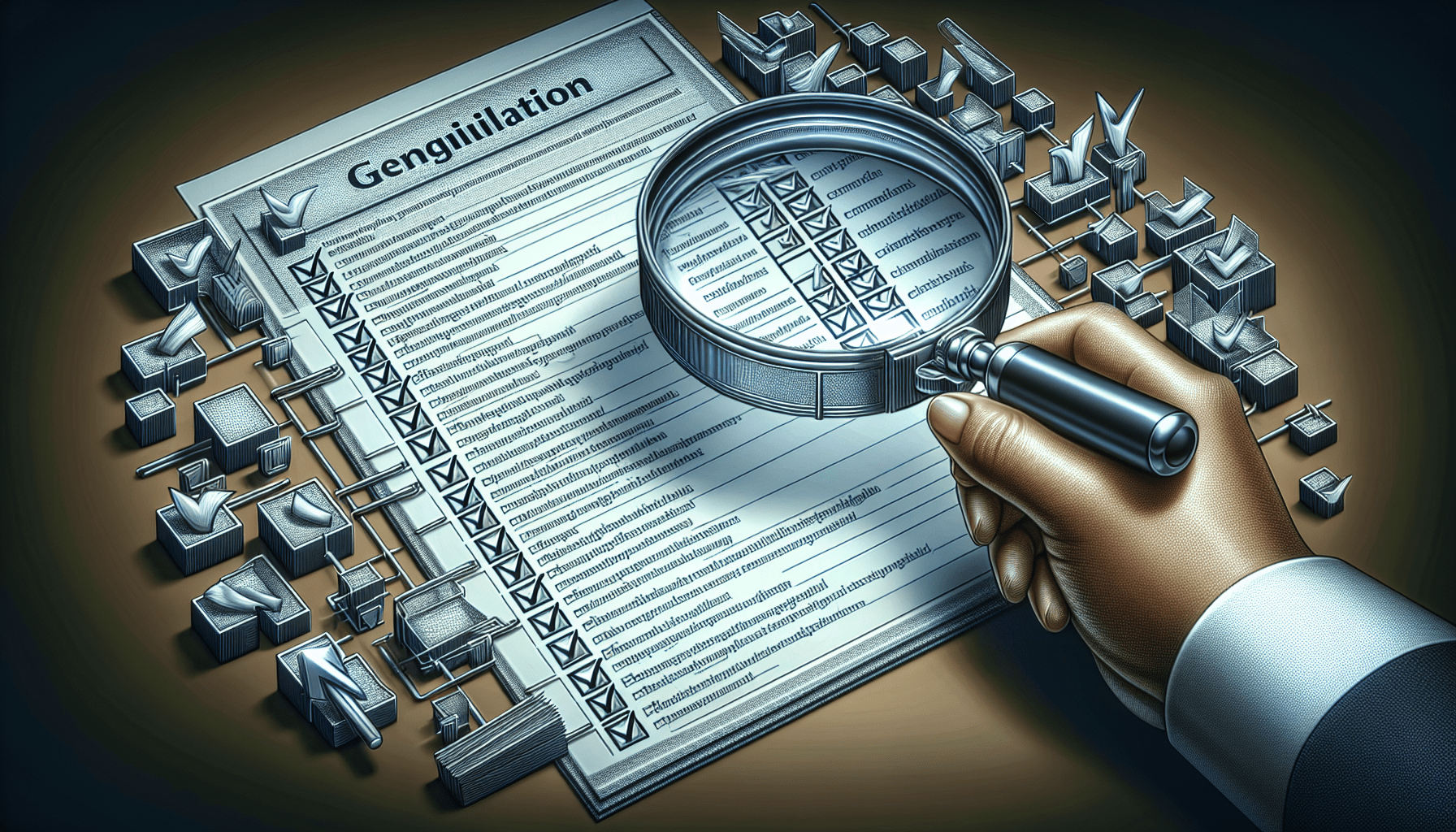In the ever-evolving landscape of business regulations, compliance audits have become an essential tool for organizations to ensure that they are adhering to legal and ethical standards. Navigating the complex world of compliance audits requires a thorough understanding of the intricacies involved, as well as a meticulous approach towards documentation and evidence gathering. This article provides an insightful exploration into the challenges faced by businesses in the realm of compliance audits, while offering valuable tips and strategies to successfully navigate this intricate process.

Understanding Compliance Audits
Definition of a compliance audit
A compliance audit is a systematic review and evaluation of an organization’s adherence to external regulations, laws, industry standards, and internal policies. It aims to ensure that the organization is operating within the boundaries set by relevant authorities and is meeting its legal and ethical obligations. The audit examines various areas of the organization, such as business practices, data privacy, employee health and safety, financial reporting, and more, to identify potential compliance issues and risks.
Importance of compliance audits
Compliance audits play a crucial role in helping organizations maintain legal and ethical conduct. By conducting regular audits, businesses can identify and mitigate compliance risks, enhance operational efficiency, and build trust with stakeholders. Compliance audits also help organizations avoid legal and financial penalties that may result from non-compliance. Additionally, compliance audits provide a competitive advantage by demonstrating a commitment to best practices and ethical business conduct.
Types of compliance audits
Compliance audits can vary based on the focus and purpose of the audit. Some common types of compliance audits include financial compliance audits, information security audits, environmental compliance audits, healthcare compliance audits, and labor laws compliance audits. Each type of audit targets specific regulations and requirements relevant to the industry and business operations. Conducting multiple types of compliance audits can provide a comprehensive review of an organization’s compliance efforts.
Preparing for a Compliance Audit
Identifying applicable regulations
Before conducting a compliance audit, it is essential to identify and understand the regulations applicable to the organization. This involves staying updated on the latest laws and industry standards that govern the organization’s operations. Compliance professionals should work closely with legal and regulatory teams to ensure comprehensive knowledge of the relevant regulations. Identifying applicable regulations sets the foundation for designing an effective compliance strategy.
Developing a compliance strategy
A well-defined compliance strategy outlines how the organization will meet its obligations and maintain compliance with applicable regulations. The strategy should consider the organization’s specific industry, operations, and risk profile. It should define key objectives, assign responsibilities, establish communication channels, and outline processes for monitoring and reporting compliance. Developing a compliance strategy ensures a proactive approach to compliance management and helps in aligning efforts across the organization.
Creating an audit checklist
An audit checklist is a crucial tool in conducting a compliance audit. It serves as a comprehensive guide and ensures that all relevant areas and requirements are evaluated during the audit process. The checklist should be tailored to the specific regulations and industry standards applicable to the organization. It should include detailed questions and criteria to assess compliance in different areas such as policies, procedures, employee training, record-keeping, and more. Creating a thorough audit checklist helps auditors stay organized and ensures a comprehensive examination of compliance.
Training staff members
To prepare for a compliance audit, it is important to train staff members on relevant regulations, policies, and procedures. This ensures that employees understand their roles and responsibilities in maintaining compliance. Training programs should cover key compliance areas, potential risks, reporting mechanisms, and the consequences of non-compliance. Regular training and communication efforts foster a culture of compliance and enable employees to contribute effectively to compliance audit processes.
Conducting a Compliance Audit
Selecting an auditor
Choosing a skilled and impartial auditor is critical to the success of a compliance audit. The auditor should have expertise in the specific regulations and industry standards relevant to the organization. They should be independent, objective, and free from any conflicts of interest. Organizations can consider hiring external auditors who specialize in compliance audits or assigning internal resources with the necessary qualifications and impartiality. Selecting the right auditor ensures the integrity and accuracy of the audit process.
Establishing audit scope and objectives
Defining the audit scope and objectives is essential to ensure that the audit focuses on the most critical compliance areas and risks. The scope should outline the specific functions, departments, or processes to be audited, while the objectives should define the desired outcomes of the audit. This clarity helps auditors allocate resources effectively and enables organizations to address compliance concerns with greater precision.
Performing risk assessments
Risk assessments are an integral part of compliance audits as they help identify and prioritize potential compliance risks. By evaluating the likelihood and impact of various compliance issues, organizations can allocate resources and prioritize mitigation efforts accordingly. Risk assessments also assist in designing controls and procedures that minimize the probability of non-compliance. Conducting thorough risk assessments enables organizations to proactively manage compliance and reduce the chances of compliance violations.
Collecting and analyzing data
During a compliance audit, auditors collect and analyze relevant data to assess the organization’s adherence to regulations and internal policies. This may involve reviewing documentation, conducting interviews, and examining evidence of compliance activities. Effective data collection ensures that auditors have the necessary information to evaluate compliance and identify any gaps or areas for improvement. Data analysis helps auditors draw conclusions, make informed recommendations, and provide valuable insights for compliance enhancement.
Evaluating compliance findings
Once the data has been collected and analyzed, auditors evaluate the compliance findings to assess the organization’s overall compliance posture. Compliance findings may include instances of non-compliance, areas of improvement, or potential risks. Evaluating compliance findings helps identify the root causes of non-compliance, determine the adequacy of existing controls, and recommend corrective measures. It is essential to document and communicate the compliance findings to key stakeholders for effective decision-making and remediation.
Key Areas of Focus in Compliance Audits
Business practices and operations
Compliance audits evaluate the organization’s business practices and operations to ensure adherence to applicable regulations, industry standards, and internal policies. This includes assessing the effectiveness of internal controls, risk management processes, and corporate governance practices. Auditors examine areas such as procurement practices, contract management, regulatory reporting, and conflicts of interest. Comprehensive evaluation of business practices and operations enables organizations to identify areas for improvement and align their processes with compliance requirements.
Data privacy and security
In an increasingly data-driven world, compliance audits focus on data privacy and security measures. Auditors assess an organization’s data protection practices, including data collection, storage, access controls, and data breach response protocols. They ensure compliance with data protection regulations such as the General Data Protection Regulation (GDPR) and industry best practices. Data privacy and security compliance audits help protect sensitive information, build customer trust, and safeguard against data breaches and penalties.
Employee health and safety
Compliance audits assess an organization’s compliance with health and safety regulations to ensure a safe working environment for employees. Auditors review workplace safety policies, procedures, and training programs to determine compliance with applicable laws and regulations. This includes evaluating measures such as hazard identification, risk assessments, emergency preparedness, safety training, and reporting mechanisms. Maintaining compliance with employee health and safety regulations protects employees’ well-being and reduces the risk of accidents and legal liabilities.
Financial reporting
Financial reporting compliance audits focus on ensuring the accuracy, transparency, and integrity of an organization’s financial statements. Auditors examine financial records, internal controls, accounting practices, and compliance with accounting principles and regulations. This includes reviewing processes such as financial statement preparation, internal and external audits, revenue recognition, expense management, and financial disclosures. Adhering to financial reporting standards and regulations helps maintain trust with stakeholders and provides accurate financial information for decision-making.
Environmental regulations
Compliance audits for environmental regulations assess an organization’s practices and procedures related to environmental protection and sustainability. Auditors evaluate compliance with regulations pertaining to waste management, pollution control, resource conservation, and environmental impact assessments. They review environmental policies, permit requirements, monitoring systems, and environmental management plans. Ensuring compliance with environmental regulations demonstrates corporate social responsibility and helps minimize the organization’s environmental footprint.
Labor laws
Labor laws compliance audits aim to assess an organization’s compliance with laws and regulations governing employment practices. Auditors review employment contracts, wage and hour policies, employee benefits, working conditions, anti-discrimination policies, and compliance with labor rights. They ensure compliance with regulations such as the Fair Labor Standards Act (FLSA), Equal Employment Opportunity (EEO) laws, and workplace safety regulations. Adhering to labor laws promotes fair and equitable treatment of employees and reduces the risk of legal disputes.
Ethical conduct and anti-corruption
Ethical conduct and anti-corruption compliance audits focus on evaluating an organization’s commitment to ethical business practices and its efforts to prevent corruption. Auditors review ethical codes of conduct, anti-corruption policies, whistleblower programs, and due diligence processes. They assess compliance with anti-corruption laws such as the Foreign Corrupt Practices Act (FCPA) and the UK Bribery Act. Conducting ethical conduct and anti-corruption audits helps mitigate legal and reputational risks and ensures ethical decision-making throughout the organization.
Advertising and marketing compliance
Compliance audits in advertising and marketing assess an organization’s compliance with regulations and industry standards governing advertising and promotional activities. Auditors review marketing materials, advertising claims, promotions, and consumer protection practices. They ensure compliance with laws such as the Federal Trade Commission (FTC) Act and specific industry guidelines. Adhering to advertising and marketing compliance regulations promotes fair and transparent practices, protects consumers, and maintains a competitive and ethical marketplace.

Common Challenges in Compliance Audits
Complex and evolving regulations
One of the significant challenges in compliance audits is the complexity and constant evolution of regulations. Organizations must stay updated on new and changing regulations relevant to their industry and business operations. This requires ongoing monitoring, interpretation, and implementation of regulatory changes. To overcome this challenge, organizations can establish partnerships with legal experts and regulatory consultants, subscribe to regulatory update services, and allocate resources for continuous regulatory awareness.
Limited internal resources
Conducting a comprehensive compliance audit requires adequate resources, including skilled professionals, time, and technology. Many organizations face challenges due to limited internal resources, particularly in smaller or resource-constrained businesses. Such limitations can lead to difficulties in conducting thorough and timely audits. Organizations may consider outsourcing certain aspects of compliance audits or investing in technology solutions to optimize resource allocation and enhance the audit process.
Lack of knowledge and awareness
Compliance audits require a high level of knowledge and awareness of the applicable regulations, industry standards, and internal policies. However, organizations may face challenges with staff members who lack sufficient knowledge or training in compliance. This can result in oversight of compliance requirements or inadequate implementation of controls. Providing regular training and awareness programs, fostering a culture of compliance, and leveraging external expertise can help address this challenge and enhance compliance understanding.
Difficulty in data collection and analysis
Data collection and analysis are critical components of compliance audits, but they can be challenging due to various factors. Organizations may struggle with collecting relevant data from disparate systems or maintaining accurate and complete records. Analyzing complex data sets can also pose challenges, especially without the right tools and expertise. By implementing data management systems, automating data collection processes, and leveraging analytics tools, organizations can streamline these tasks and improve the efficiency and accuracy of the audit process.
Addressing audit findings and implementing corrective actions
After a compliance audit, organizations may face challenges in addressing the identified compliance issues and implementing necessary corrective actions. This could include ensuring accountability, allocating resources, and resolving systemic issues. Without a systematic approach to addressing audit findings, organizations may struggle to implement sustainable solutions. By establishing clear accountability, developing action plans, and monitoring progress, organizations can effectively address audit findings and continuously improve their compliance efforts.
Benefits of Compliance Audits
Identifying and mitigating compliance risks
Compliance audits help organizations identify and assess potential compliance risks. By evaluating current practices, controls, and procedures, audits reveal areas of non-compliance or potential vulnerabilities. This enables organizations to take proactive measures to mitigate the identified risks and strengthen their compliance posture. By addressing these risks, organizations can avoid potential legal and financial penalties, reputational damage, and operational disruptions.
Enhancing operational efficiency
Through compliance audits, organizations can identify opportunities for streamlining processes, eliminating redundancies, and enhancing operational efficiency. Audits highlight areas where there may be gaps or inefficiencies in compliance-related activities. By optimizing processes and implementing automation or technology solutions, organizations can improve efficiency, reduce costs, and allocate resources more effectively. Enhanced operational efficiency also contributes to overall organizational effectiveness and resilience.
Improving reputation and trust
Maintaining a strong compliance program and demonstrating a commitment to ethical conduct builds trust and enhances the organization’s reputation. Compliance audits provide evidence of the organization’s dedication to meeting regulatory requirements and handling sensitive information responsibly. By consistently adhering to compliance standards and promptly addressing any compliance issues, organizations foster trust with customers, employees, investors, and other stakeholders. A positive reputation for compliance can differentiate the organization in the marketplace and attract more business opportunities.
Avoiding legal and financial penalties
Non-compliance with applicable regulations can result in severe legal and financial consequences for organizations. Compliance audits help identify compliance violations or potential areas of non-compliance, allowing organizations to take corrective actions proactively. By addressing non-compliance issues promptly, organizations can avoid penalties, fines, and legal liabilities. The cost savings from avoiding legal and financial penalties can be significant and contribute to the organization’s overall financial health.
Gaining a competitive advantage
In today’s business landscape, compliance is not just a legal obligation, but also a competitive advantage. Compliance audits demonstrate an organization’s commitment to ethical business practices, risk management, and customer trust. With an effective compliance program in place, organizations can differentiate themselves from competitors and attract customers who prioritize ethical business conduct. Compliance audits also provide valuable insights into industry best practices and allow organizations to adapt and improve their operations, giving them a competitive edge.
Selecting an Audit Management Software
Understanding the need for audit software
Audit management software offers various benefits in streamlining and automating the compliance audit process. It helps in organizing and managing audit documentation, tracking findings and corrective actions, and facilitating collaboration among audit teams. Audit software enhances data analysis, reporting capabilities, and helps ensure consistency and standardization in the audit process. By replacing manual and paper-based methods, audit software improves efficiency, accuracy, and overall effectiveness in conducting compliance audits.
Key features and functionalities to consider
When selecting audit management software, organizations should consider key features and functionalities that align with their specific compliance audit needs. Some essential features to consider include document management, tracking and reporting capabilities, configurable workflows, issue tracking and remediation, risk assessment tools, integration with existing systems, and user-friendly interfaces. It’s also crucial to ensure that the software provides sufficient security measures to protect sensitive audit data.
Assessing compatibility with existing systems
Organizations should evaluate the compatibility of audit management software with their existing systems, such as enterprise resource planning (ERP) systems, customer relationship management (CRM) systems, or document management systems. Seamless integration between the audit software and existing systems improves data sharing, eliminates duplication of effort, and facilitates efficient information exchange. Compatibility also enables organizations to leverage existing data and system functionalities to enhance the audit process.
Considering scalability and flexibility
Organizations should consider the scalability and flexibility of audit management software to accommodate future growth and changing compliance requirements. The software should be capable of handling increasing volumes of audits, expanding user bases, and evolving compliance regulations. It should allow for customization and configuration based on the organization’s unique needs and provide flexibility to adapt to changing industry standards or regulations. Scalable and flexible software ensures long-term usability and cost-effectiveness.
Evaluating vendor reputation and support
When selecting audit management software, it is essential to evaluate the reputation and support provided by the software vendor. Consider factors such as the vendor’s experience and track record in the industry, customer reviews and testimonials, and the vendor’s commitment to ongoing support and updates. A reputable vendor with excellent customer support ensures that the organization receives timely assistance, software updates, and continuous improvements throughout the software’s lifecycle.
Best Practices in Compliance Audits
Maintaining up-to-date knowledge of regulations
Compliance professionals should stay updated on the latest regulations, industry standards, and internal policies relevant to their organization. This includes monitoring regulatory changes, attending industry conferences and seminars, participating in professional networks, and utilizing regulatory update services. By maintaining up-to-date knowledge, compliance professionals can effectively identify compliance risks, proactively address changes, and ensure compliance programs are current and comprehensive.
Establishing clear policies and procedures
Clear and well-documented policies and procedures are essential for effective compliance management. Policies should outline the organization’s expectations, standards, and guidelines regarding compliance. Procedures should provide step-by-step instructions on implementing and enforcing these policies. Clear policies and procedures ensure consistency, accountability, and a shared understanding of compliance requirements throughout the organization. Regular review and communication of policies and procedures help ensure compliance remains a top priority.
Implementing regular self-assessments
In addition to formal compliance audits, organizations should conduct regular self-assessments or internal reviews. Self-assessments involve internal teams evaluating compliance practices, processes, and controls against established standards. This helps organizations identify potential compliance issues before they become more significant problems and allows for timely corrective actions. Regular self-assessments also reinforce a culture of compliance, empower employees to participate in compliance efforts, and provide valuable insights for improvement.
Maintaining proper documentation and record-keeping
Thorough documentation is crucial in compliance audits to demonstrate adherence to regulations and provide evidence of compliance efforts. Organizations should maintain comprehensive records of policies, procedures, training documentation, audit reports, and corrective action plans. Documenting compliance-related activities ensures transparency, supports audit trails, and helps in addressing any compliance concerns effectively. Robust record-keeping practices also fulfill legal requirements and facilitate communication with auditors and regulatory authorities.
Leveraging technology and automation
Technology and automation play a vital role in enhancing the efficiency and effectiveness of compliance audits. Organizations can leverage audit management software, data analytics tools, and automation solutions to streamline audit processes, improve data collection and analysis, and enhance reporting capabilities. Technology solutions help reduce manual efforts, minimize errors, and provide real-time visibility into compliance status. By embracing technology and automation, organizations can optimize resources, improve audit outcomes, and achieve greater compliance assurance.
Auditor Independence and Objectivity
Ensuring impartiality and independence
Auditor independence is critical to the integrity and credibility of compliance audits. It ensures that auditors remain unbiased and objective in their assessment of the organization’s compliance efforts. Independence requires auditors to be free from any conflicts of interest, personal or professional, that may compromise their ability to provide an impartial evaluation. Organizations should establish policies and procedures that promote auditor independence and ensure auditors are free to exercise professional judgment without undue influence.
Managing conflicts of interest
Conflicts of interest can undermine the independence and objectivity of auditors, potentially leading to biased audit findings. Organizations should implement processes to identify and address conflicts of interest that auditors may have. This may involve conducting conflict of interest checks, requiring auditors to disclose any potential conflicts, or assigning auditors who are independent of the area being audited. By proactively managing conflicts of interest, organizations can maintain the integrity and objectivity of compliance audits.
Preserving objectivity throughout the audit process
Maintaining objectivity throughout the audit process is crucial for auditors to provide accurate and unbiased assessments. Auditors should approach the audit with an open mind, objectively evaluate evidence, and avoid preconceived notions. They should exercise professional skepticism and refrain from any personal biases or conflicts that may influence their judgment. Organizations should promote and support a culture of objectivity, encourage open dialogue between auditors and management, and provide resources to help auditors remain independent throughout the audit process.
Continuous Improvement in Compliance
Analyzing audit findings for improvement opportunities
Compliance audits provide valuable insights into an organization’s compliance program and areas for improvement. Organizations should carefully analyze audit findings to identify patterns, root causes, and improvement opportunities. This analysis should involve a collaborative effort between compliance professionals, auditors, and relevant stakeholders. By analyzing audit findings, organizations can develop targeted improvement strategies, allocate resources effectively, and enhance compliance effectiveness over time.
Implementing corrective actions and monitoring progress
Addressing audit findings and implementing corrective actions are crucial steps in continuous improvement. Organizations should develop action plans based on audit findings, clearly defining responsibilities and timelines for corrective actions. Regular monitoring and progress tracking ensure that corrective actions are being effectively implemented and are achieving the desired outcomes. Monitoring progress also provides opportunities to identify any emerging compliance risks or corrective action needs before they escalate.
Regularly reviewing and updating compliance programs
Regulatory requirements, industry standards, and organizational operations are dynamic and continually evolving. To ensure the effectiveness of compliance programs, organizations should regularly review and update their compliance procedures, policies, and controls. This should include periodic assessments of the relevance and adequacy of compliance programs, taking into account changes in regulations, industry best practices, and internal factors. Regular reviews and updates demonstrate a commitment to ongoing improvement and facilitate compliance with changing requirements.
Encouraging a culture of compliance and accountability
Promoting a culture of compliance and accountability is vital for fostering a proactive and sustainable approach to compliance. The tone from the top, ethical leadership, and clear communication of expectations play a significant role in establishing such a culture. Organizations should encourage open dialogue, provide regular training and awareness programs, and recognize and reward compliance achievements. By instilling a culture of compliance, organizations empower employees to take ownership of their compliance responsibilities and actively contribute to a compliant and ethical workplace.
In conclusion, compliance audits are essential for organizations to ensure adherence to regulations, manage risks, and maintain a culture of compliance. By understanding the definition, importance, and types of compliance audits, organizations can prepare effectively and conduct thorough audits. Key areas of focus in compliance audits range from business practices and operations to data privacy, employee health and safety, financial reporting, environmental regulations, labor laws, and more. Overcoming common challenges, leveraging technology, and following best practices enhance compliance audit effectiveness. Auditor independence, continuous improvement efforts, and a culture of compliance contribute to long-term compliance success. Ultimately, compliance audits enable organizations to identify and mitigate risks, improve operational efficiency, maintain reputation and trust, and gain a competitive advantage in today’s complex business landscape.



